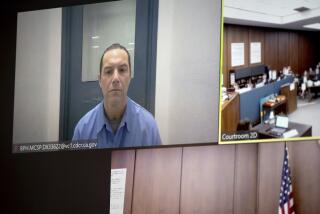Slaying turns up heat on legal system
Each year, the Los Angeles County court system handles more than 20,000 cases of felony domestic violence.
But those who have long dealt with the issue said they would be hard-pressed to find another case in which the system so failed the victim as the killing of Monica Thomas-Harris by her estranged husband.
“This was a complete screw-up from beginning to end,” state Sen. Sheila Kuehl (D-Santa Monica), who has written about 25 bills on domestic violence, said Wednesday. “Judges around the state were stunned that this could happen.”
As the case continued to spark outrage this week, there was a growing feeling that it might lead to a reexamination of how the justice system deals with domestic violence cases.
Experts cited numerous red flags.
First, the district attorney’s office did not seek a criminal protective order against Curtis Harris, who had a history of escalating violence toward his wife. The most recent incident came in November when he was arrested on suspicion of kidnapping his wife, binding her with duct tape and threatening her with a stun gun.
Then, when the 34-year-old ex-con agreed to plead guilty late last month to false imprisonment and possession of a firearm, the prosecutor and judge filling in on the case did not postpone the sentencing so those more familiar with the facts could review the deal.
After the plea agreement was reached, the judge and prosecutor took the virtually unheard-of step of permitting Harris to leave jail, either ignoring or missing a Probation Department report that declared him “unsuitable” for release.
“It is a shock,” said Patti Giggans, executive director of the social service agency Peace Over Violence, once known as the Los Angeles Commission on Assaults Against Women. “Because with all of the work we have been doing to make the criminal justice system work in these cases, to see it fail like this is infuriating.”
Since the bodies of Thomas-Harris and her estranged husband were discovered Saturday at a Whittier motel in an apparent murder-suicide, the district attorney’s office has launched an internal investigation into its handling of the case in the Pomona courthouse. The preliminary results from the inquiry are expected within a month, said Pamela Booth, a branch supervisor who oversees the D.A.’s office in Pomona.
At Superior Court, spokesman Allan Parachini said no formal inquiry was underway. But he said the case had prompted “a great deal of reflection here on how this occurred. And that may result in suggestions and advice that judges can rely on in the future.”
Judge Tia Tisher, who authorized Harris’ release, declined to comment, as did the presiding judges of the Pomona and criminal courts. Parachini said it was important to note that Fisher, who was substituting for the judge handling the case, was asked to rule on a negotiated plea agreement that had been handled by “two very experienced lawyers who were known to her for being competent.”
At the court proceeding Dec. 21, records and interviews show, Deputy Dist. Atty. Samer Hathout, sitting in for the original prosecutor, and Harris’ lawyer, Arthur P. Lindars, agreed that Harris would plead no contest to two felonies and be sentenced to 16 months in prison. He had also faced a charge of kidnapping, which potentially carried a much longer sentence.
As part of the plea, Parachini said, the prosecutor agreed that Harris would be given 30 days of freedom to get his affairs in order, including making arrangements for his elderly mother to continue living in his home while he was in prison.
“And the D.A. says on the record we are agreeing to an [own recognizance] release,” Parachini said, referring to the decision to let Harris go without posting bail. “So what is the judge going to do?”
At the district attorney’s office, Booth said her inquiry so far had determined that only the substitute prosecutor and her supervisor signed off on Harris’ release.
“Neither the [case] deputy nor anyone else knew there would be a request” to release Harris, she said.
Booth also said her inquiry would address why a criminal court protective order against Harris was not sought by prosecutors much earlier. Harris had a felony criminal record dating back 15 years and had accosted his estranged wife several times. The most recent incidents, which led to his arrest, occurred in November when he essentially kidnapped her, first from a West Covina park and later from her workplace in the City of Industry.
Seeking protective orders is commonly done in the early stages of domestic violence cases and can serve as a warning in future court proceedings that a defendant is considered dangerous, Booth said.
Experts in the field of domestic violence also questioned why the Probation Department’s recommendation against release did not carry more weight. The department’s report states that a probation investigator had been unable to reach West Covina police, who could have detailed Harris’ history. The police report, however, should have been available to the court. In addition, the probation investigator stated that Harris gave his wife and mother as references, but provided incorrect phone numbers for them. A third reference Harris provided hung up on the investigator, the report said.
Reflecting on the tragedy, Booth said that “99% of our domestic violence cases don’t end in violence. But 100% of the cases have that potential.”
Times staff writer Andrew Blankstein contributed to this report.
More to Read
Start your day right
Sign up for Essential California for news, features and recommendations from the L.A. Times and beyond in your inbox six days a week.
You may occasionally receive promotional content from the Los Angeles Times.






